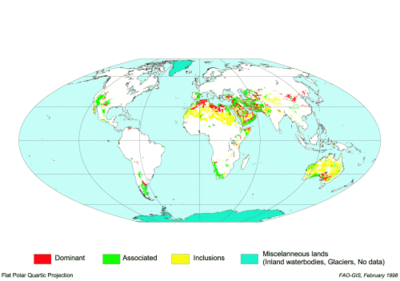Calcisol

ACalcisolin theWorld Reference Base for Soil Resources(WRB)[1]is a soil with a substantial secondary accumulation oflime.Calcisols are common incalcareousparent materialsand widespread inaridandsemi-aridenvironments. Formerly Calcisols were internationally known asDesert soilsandTakyrs.
Calcisols are developed in mostlyalluvial,colluvialandaeolian depositsofbase-richweatheringmaterial. They are found on level to hilly land in arid and semi-arid regions. The natural vegetation is sparse and dominated byxerophyticshrubsandtreesand/or ephemeral grasses.
Dryness, and in places also stoniness and/or the presence of a shallow petrocalcichorizon,limit the suitability of Calcisols for agriculture. If irrigated, drained (to preventsalinisation) andfertilised,Calcisols can be highly productive under a wide variety of crops. Hilly areas with Calcisols are predominantly used for low volume grazing ofcattle,sheepandgoats.
Many Calcisols occur together withSolonchaksthat are actually salt-affected Calcisols and/or with other soils with secondary accumulation of lime that do not key out as Calcisols. The total Calcisol area may well amount to some 10 million square kilometres, nearly all of it in the arid and semi-arid subtropics of both hemispheres.
See also
[edit]References
[edit]- ^IUSS Working Group WRB (2022)."World Reference Base for Soil Resources, fourth edition"(PDF).International Union of Soil Sciences, Vienna.
Further reading
[edit]- W. Zech, P. Schad, G. Hintermaier-Erhard: Soils of the World. Springer, Berlin 2022, Chapter 8.3.2.ISBN978-3-540-30460-9
External links
[edit]- profile photos (with classification)WRB homepage
- profile photos (with classification)IUSS World of Soils
